Maintaining balanced water in your pool is not just about keeping it looking crystal clear; it’s about ensuring a safe and healthy environment for swimmers. Poor water balance can lead to a variety of issues ranging from eye irritation to damage to the pool equipment itself. Balanced water helps prevent algae growth, maintains effective chlorine levels, and protects the pool surface and equipment. In short, water balancing is the foundation of effective pool maintenance. When the water chemistry is off, you might notice cloudy water, scaling on the pool surfaces, or even an unpleasant swimming experience. These issues are not just cosmetic—they can affect the health and safety of swimmers. That’s why understanding and maintaining the right balance of pH, alkalinity, and hardness is so important.
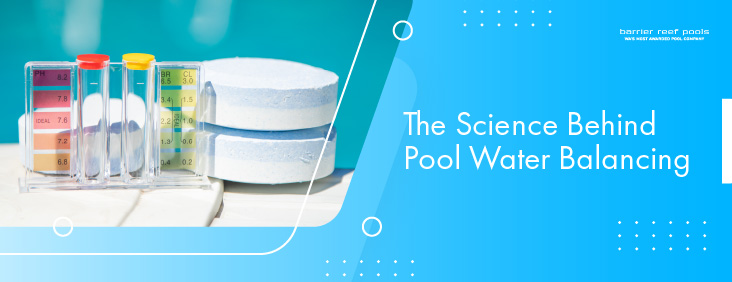
Explaining the Basics pH, Alkalinity, and Hardness
pH: The Measure of Acidity or Alkalinity
pH measures how acidic or alkaline pool water is, on a scale from 0 to 14, where 7 is neutral. Below 7 is acidic, above 7 is alkaline. Ideal pH for pool water is 7.2 to 7.6, which minimises irritation for swimmers. Low pH (acidic) can cause etching on surfaces and corrosion of metal parts. High pH (alkaline) can lead to scaling and cloudy water. Both extremes reduce chlorine effectiveness, the main pool sanitizer.
Alkalinity: Buffering the pH Levels
Alkalinity is the concentration of alkaline substances like bicarbonates, carbonates, and hydroxides, stabilising pH levels. The ideal range is 80 to 120 parts per million (ppm). Proper alkalinity stabilises pH, reducing the need for frequent adjustments. Low alkalinity causes pH fluctuations, while high alkalinity makes pH hard to change. Both make water balancing challenging.
Hardness: The Role of Calcium
Hardness is the concentration of calcium and magnesium in water, focusing on calcium hardness for pools, ideally between 200 and 400 ppm. Proper hardness prevents scaling and corrosion. Low calcium hardness leads to plaster etching and metal corrosion, while high calcium hardness causes scaling and cloudy water. Balancing calcium hardness protects the pool structure and ensures clear water.
The Science Behind Each Element
How pH Affects Chlorine Efficiency
Chlorine is most effective when the pH level is between 7.2 and 7.6. If the pH is too high, chlorine becomes less effective at killing bacteria and algae. If the pH is too low, chlorine can be overly active, depleting quickly and potentially irritating swimmers. Keeping the pH level within the ideal range ensures chlorine works effectively, keeping the water safe and clean. Regular testing and adjustments are necessary to maintain the right pH and optimal chlorine efficiency.
The Role of Alkalinity in Buffering pH
Alkalinity stabilises the pH level, preventing rapid changes due to factors like rain, debris, and swimmer load. Proper alkalinity helps keep the pH stable, reducing the need for frequent adjustments. High alkalinity can make pH adjustments difficult, while low alkalinity can cause wide pH fluctuations. Regular testing and adjustments of alkalinity are essential for a stable pH.
The Impact of Hardness on Equipment and Water Clarity
Calcium hardness protects pool surfaces and equipment. Low calcium hardness can lead to corrosion and plaster etching, while high calcium hardness can cause scaling, seen as white or gray deposits. Maintaining the proper calcium hardness prevents these issues, keeping the pool in good condition and the water clear. Regular testing and adjustments of calcium hardness protect the pool and maintain water clarity.
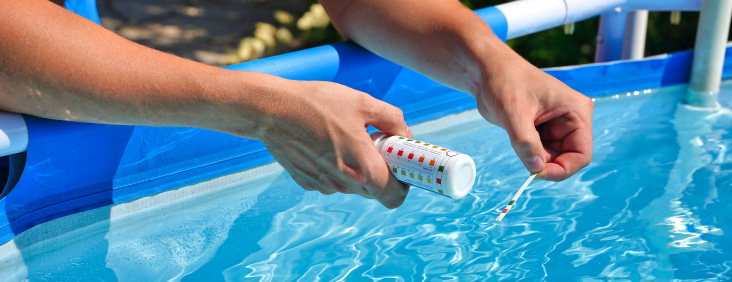
Practical Advice on Testing and Adjusting Parameters
Regular Testing is Key
To keep pool water balanced, regular testing is crucial. Invest in a quality test kit or digital tester that measures pH, alkalinity, and calcium hardness. Test your pool water at least once a week, and more often if the pool is heavily used or exposed to heavy rain.
Adjusting pH Levels
If the pH is too high, add a pH reducer (such as muriatic acid or sodium bisulfate). If the pH is too low, use a pH increaser (such as soda ash or sodium carbonate). Follow the manufacturer’s instructions for the correct dosage.
Balancing Alkalinity
To increase alkalinity, add an alkalinity increaser (such as sodium bicarbonate). To decrease alkalinity, use an acid (such as muriatic acid). Adjust gradually and retest after each step to avoid overshooting.
Managing Calcium Hardness
To increase calcium hardness, add a calcium hardness increaser (such as calcium chloride). If the hardness is too high, partially drain and refill the pool with fresh water to dilute the calcium. Regular testing and adjustments will help maintain the proper calcium hardness level.
Common Misconceptions and Mistakes in Pool Water Balancing
Overlooking Regular Testing
A common mistake is neglecting regular pool water testing. Without it, you can’t know if the water is balanced, and problems can develop unnoticed. Make testing a routine part of your maintenance to catch issues early and keep the water balanced.
Misunderstanding pH and Alkalinity Relationship
Another misconception is not understanding the relationship between pH and alkalinity. Some pool owners adjust pH without considering alkalinity, leading to unstable water chemistry. Remember, alkalinity buffers pH, and both need to be balanced together.
Ignoring Calcium Hardness
Many pool owners focus on pH and alkalinity but overlook calcium hardness. Ignoring it can lead to scaling or corrosion issues, affecting the pool’s longevity and water clarity. Include calcium hardness testing and adjustments in your regular maintenance.
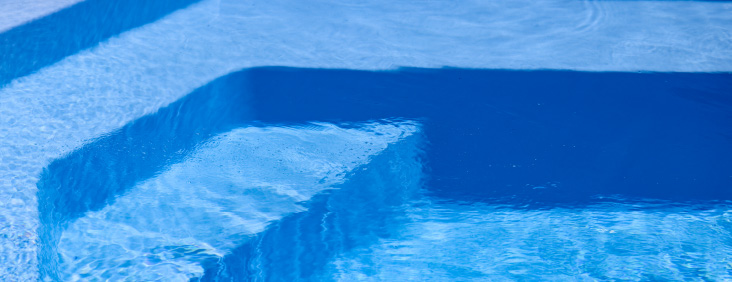
The Environmental Impact of Proper Pool Water Balancing
Reducing Chemical Usage
Proper water balancing reduces the need for excessive chemical use. Balanced water requires fewer adjustments and less frequent additions of chemicals, which is better for the environment and reduces chemical runoff.
Extending Equipment Life
Balanced water helps protect pool equipment from corrosion and scaling, extending its lifespan. This reduces the need for replacements and repairs, saving resources and reducing waste.
Minimising Waste Water
Maintaining balanced water minimises the need for frequent draining and refilling of the pool. This conserves water and reduces the environmental impact of pool maintenance, contributing to more sustainable practices.
Health, Safety, and Longevity Benefits
Maintaining balanced pool water is essential for ensuring a safe, clean, and enjoyable swimming environment. By understanding and managing pH, alkalinity, and hardness, pool owners can prevent common issues, protect their investment, and enjoy crystal-clear water year-round. Regular testing and adjustments, along with the use of modern tools and technology, make water balancing easier and more efficient. By prioritising water balance, you contribute to a healthier environment and extend the life of your pool.
The Science Behind Pool Water Balancing
Maintaining balanced water in your pool is not just about keeping it looking crystal clear; it’s about ensuring a safe and healthy environment for swimmers. Poor water balance can lead to a variety of issues ranging from eye irritation to damage to the pool equipment itself. Balanced water helps prevent algae growth, maintains effective chlorine levels, and protects the pool surface and equipment. In short, water balancing is the foundation of effective pool maintenance. When the water chemistry is off, you might notice cloudy water, scaling on the pool surfaces, or even an unpleasant swimming experience. These issues are not just cosmetic—they can affect the health and safety of swimmers. That’s why understanding and maintaining the right balance of pH, alkalinity, and hardness is so important.
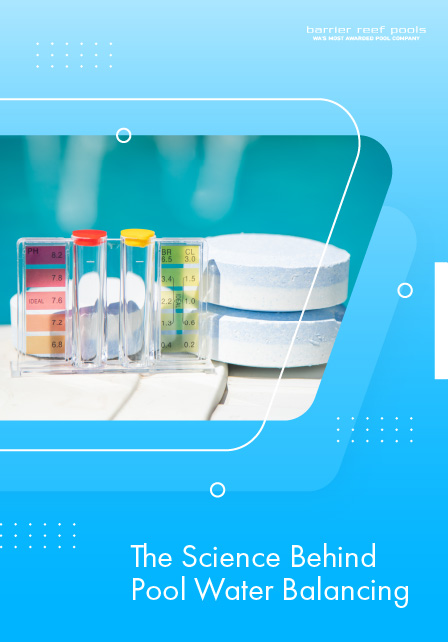
Explaining the Basics pH, Alkalinity, and Hardness
pH: The Measure of Acidity or Alkalinity
pH measures how acidic or alkaline pool water is, on a scale from 0 to 14, where 7 is neutral. Below 7 is acidic, above 7 is alkaline. Ideal pH for pool water is 7.2 to 7.6, which minimises irritation for swimmers. Low pH (acidic) can cause etching on surfaces and corrosion of metal parts. High pH (alkaline) can lead to scaling and cloudy water. Both extremes reduce chlorine effectiveness, the main pool sanitizer.
Alkalinity: Buffering the pH Levels
Alkalinity is the concentration of alkaline substances like bicarbonates, carbonates, and hydroxides, stabilising pH levels. The ideal range is 80 to 120 parts per million (ppm). Proper alkalinity stabilises pH, reducing the need for frequent adjustments. Low alkalinity causes pH fluctuations, while high alkalinity makes pH hard to change. Both make water balancing challenging.
Hardness: The Role of Calcium
Hardness is the concentration of calcium and magnesium in water, focusing on calcium hardness for pools, ideally between 200 and 400 ppm. Proper hardness prevents scaling and corrosion. Low calcium hardness leads to plaster etching and metal corrosion, while high calcium hardness causes scaling and cloudy water. Balancing calcium hardness protects the pool structure and ensures clear water.
The Science Behind Each Element
How pH Affects Chlorine Efficiency
Chlorine is most effective when the pH level is between 7.2 and 7.6. If the pH is too high, chlorine becomes less effective at killing bacteria and algae. If the pH is too low, chlorine can be overly active, depleting quickly and potentially irritating swimmers. Keeping the pH level within the ideal range ensures chlorine works effectively, keeping the water safe and clean. Regular testing and adjustments are necessary to maintain the right pH and optimal chlorine efficiency.
The Role of Alkalinity in Buffering pH
Alkalinity stabilises the pH level, preventing rapid changes due to factors like rain, debris, and swimmer load. Proper alkalinity helps keep the pH stable, reducing the need for frequent adjustments. High alkalinity can make pH adjustments difficult, while low alkalinity can cause wide pH fluctuations. Regular testing and adjustments of alkalinity are essential for a stable pH.
The Impact of Hardness on Equipment and Water Clarity
Calcium hardness protects pool surfaces and equipment. Low calcium hardness can lead to corrosion and plaster etching, while high calcium hardness can cause scaling, seen as white or gray deposits. Maintaining the proper calcium hardness prevents these issues, keeping the pool in good condition and the water clear. Regular testing and adjustments of calcium hardness protect the pool and maintain water clarity.
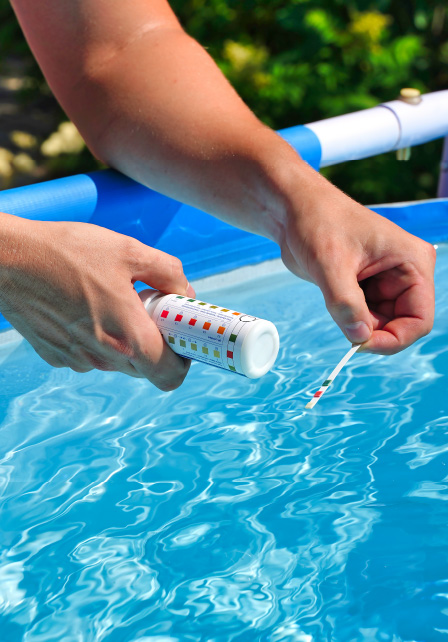
Practical Advice on Testing and Adjusting Parameters
Regular Testing is Key
To keep pool water balanced, regular testing is crucial. Invest in a quality test kit or digital tester that measures pH, alkalinity, and calcium hardness. Test your pool water at least once a week, and more often if the pool is heavily used or exposed to heavy rain.
Adjusting pH Levels
If the pH is too high, add a pH reducer (such as muriatic acid or sodium bisulfate). If the pH is too low, use a pH increaser (such as soda ash or sodium carbonate). Follow the manufacturer’s instructions for the correct dosage.
Balancing Alkalinity
To increase alkalinity, add an alkalinity increaser (such as sodium bicarbonate). To decrease alkalinity, use an acid (such as muriatic acid). Adjust gradually and retest after each step to avoid overshooting.
Managing Calcium Hardness
To increase calcium hardness, add a calcium hardness increaser (such as calcium chloride). If the hardness is too high, partially drain and refill the pool with fresh water to dilute the calcium. Regular testing and adjustments will help maintain the proper calcium hardness level.
Common Misconceptions and Mistakes in Pool Water Balancing
Overlooking Regular Testing
A common mistake is neglecting regular pool water testing. Without it, you can’t know if the water is balanced, and problems can develop unnoticed. Make testing a routine part of your maintenance to catch issues early and keep the water balanced.
Misunderstanding pH and Alkalinity Relationship
Another misconception is not understanding the relationship between pH and alkalinity. Some pool owners adjust pH without considering alkalinity, leading to unstable water chemistry. Remember, alkalinity buffers pH, and both need to be balanced together.
Ignoring Calcium Hardness
Many pool owners focus on pH and alkalinity but overlook calcium hardness. Ignoring it can lead to scaling or corrosion issues, affecting the pool’s longevity and water clarity. Include calcium hardness testing and adjustments in your regular maintenance.
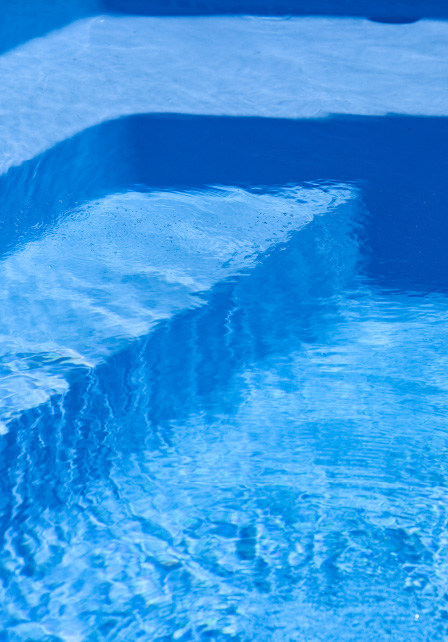
The Environmental Impact of Proper Pool Water Balancing
Reducing Chemical Usage
Proper water balancing reduces the need for excessive chemical use. Balanced water requires fewer adjustments and less frequent additions of chemicals, which is better for the environment and reduces chemical runoff.
Extending Equipment Life
Balanced water helps protect pool equipment from corrosion and scaling, extending its lifespan. This reduces the need for replacements and repairs, saving resources and reducing waste.
Minimising Waste Water
Maintaining balanced water minimises the need for frequent draining and refilling of the pool. This conserves water and reduces the environmental impact of pool maintenance, contributing to more sustainable practices.
Health, Safety, and Longevity Benefits
Maintaining balanced pool water is essential for ensuring a safe, clean, and enjoyable swimming environment. By understanding and managing pH, alkalinity, and hardness, pool owners can prevent common issues, protect their investment, and enjoy crystal-clear water year-round. Regular testing and adjustments, along with the use of modern tools and technology, make water balancing easier and more efficient. By prioritising water balance, you contribute to a healthier environment and extend the life of your pool.




